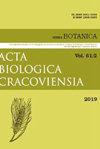Effect of D Genome on Wheat Anther Culture Response After Cold and Mannitol Pretreatment
IF 0.5
4区 生物学
Q4 PLANT SCIENCES
引用次数: 11
Abstract
The present study was conducted to determine the effect of the D genome on embryoid induction and green plant regeneration in wheat anther culture and how it is influenced by low temperature and mannitol treatment. For this reason, the anther culture response of two Canadian bread wheat cultivars and their extracted tetraploids (AABB) was studied. As controls two cultivars well responding to anther-culture (i.e. cvs. Kavkaz/Cgn and Acheron) and a no-responding cultivar (cv. Vergina) were used. Approximately 3000 anthers of these cultivars were cultured and three pre-treatments were applied: cold pre-treatment for 7 and 18 days at 4oC, and 0.3M mannitol for seven days at 4oC. W14 and 190-2 were used as induction and regeneration media, respectively, and the basic MS medium as the rooting medium. No green plants were produced from the tetraploids, which supports the view that the D-genome chromosomes are necessary for androgenic response in wheat. Furthermore, the Canadian cultivars performed better after 18-day pre-treatment at 4oC. The extracted tetraploids produced fewer embryoids and performed better after seven days of cold pre-treatment. The controls well responding to anther culture performed better than the Canadian cultivars, although their best response was recorded after seven-day cold pre-treatment. Cultivar Vergina produced no green plants. The presence of mannitol influenced negatively both embryoid and green plant production. It was concluded that the D genome plays a crucial role in anther culture response of wheat and that this response is influenced by both the genotype and the duration of cold pre-treatment.D基因组对低温和甘露醇预处理后小麦花药培养响应的影响
本研究旨在研究D基因组在小麦花药培养中对胚状体诱导和绿色植株再生的影响,以及低温和甘露醇处理对其的影响。为此,研究了两个加拿大面包小麦品种及其提取的四倍体(AABB)的花药培养反应。作为对照,两个品种对花药培养反应良好(即cvs)。Kavkaz/Cgn和Acheron)和一个无反应的品种(cv。使用Vergina)。采用3种预处理方法,分别在4℃条件下冷预处理7天和18 d,在4℃条件下用0.3M甘露醇处理7 d。W14和190-2分别作为诱导培养基和再生培养基,基本MS培养基作为生根培养基。四倍体没有产生绿色植株,这支持了d基因组染色体是小麦雄激素反应所必需的观点。此外,加拿大品种在4℃预处理18 d后表现更好。冷预处理7天后,提取的四倍体产生的胚状体较少,表现较好。对照对花药培养反应良好,表现优于加拿大品种,尽管它们的最佳反应是在7天的冷预处理后记录的。品种Vergina不产生绿色植株。甘露醇的存在对胚状体和绿色植物的生产都有负面影响。综上所述,D基因组在小麦花药培养反应中起着至关重要的作用,这种反应受基因型和冷预处理时间的影响。
本文章由计算机程序翻译,如有差异,请以英文原文为准。
求助全文
约1分钟内获得全文
求助全文
来源期刊
CiteScore
3.00
自引率
0.00%
发文量
0
审稿时长
>12 weeks
期刊介绍:
ACTA BIOLOGICA CRACOVIENSIA Series Botanica is an English-language journal founded in 1958, devoted to plant anatomy and morphology, cytology, genetics, embryology, tissue culture, physiology, biochemistry, biosystematics, molecular phylogenetics and phylogeography, as well as phytochemistry. It is published twice a year.

 求助内容:
求助内容: 应助结果提醒方式:
应助结果提醒方式:


